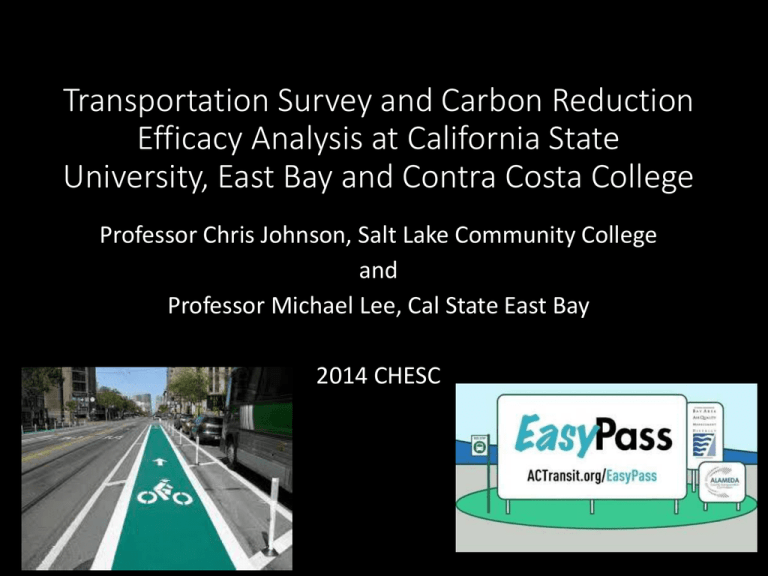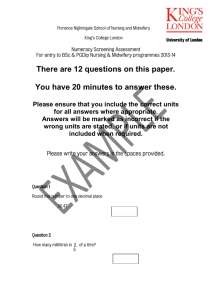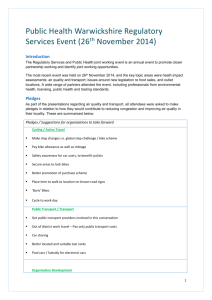Transportation Survey and Carbon-Reduction Efficacy Analysis at
advertisement

Transportation Survey and Carbon Reduction Efficacy Analysis at California State University, East Bay and Contra Costa College Professor Chris Johnson, Salt Lake Community College and Professor Michael Lee, Cal State East Bay 2014 CHESC Summary • Transportation survey metrics – Contra Costa College and Cal State East Bay • Decision-making tool • Used metrics to do carbon reduction efficacy analysis that ranked TDM strategies by $/MTCO2E • Used as many cost/savings assumptions as possible (cost to institution and students) • Most popular or least expensive strategies may not be the most efficient • Most efficient strategies vary between campuses due to geography and demographics Source: Slate.com, Sept. 22, 2013 Problem • 2012 – 72% of California college students were community college students. • Most GHG emissions at community colleges are from commuting. • Ex. 3 Bay Area community colleges - 65% – 83% of GHG emissions were from commuters. • Per the CCCCO, community colleges may be held to the GHG reduction goals of AB 32. Problem • More commuter emissions from community colleges statewide than UC and CSUs. Problem • Studies have not been conducted to determine which strategies would most effectively reduce commuter emissions, especially at community colleges. • Community colleges • least concern and most to gain • Low hanging fruit Transportation Demand Management (TDM) • How will TDM and metrics address problem? • Reduce emissions by reducing single occupancy vehicle (SOV) use and vehicle miles traveled (VMT). • This study – How reduce SOV and VMT? • Collect transportation metrics via a stated-preference survey. • Developed a economic tool that uses these metrics to identify which TDM strategy would most effectively reduce commuter emissions at the least cost to the institution and students. • Decision makers - use to prioritize strategies. • Prioritization - $/MTCO2E. Transportation Demand Management (TDM) • Common TDM Strategies • • • • • • • • • • • • Carpool parking – preference or discounted parking fee Carpool electronic forum – i.e. Zimride.com Unlimited access pass – i.e. AC Transit “Easy Pass” Bicycle infrastructure – parking, showers, repairs, etc Shuttle bus – light rail to campus (BART shuttle) Flexible work schedule Compressed work week Van pool Cash-out program – i.e. “Clean Air Cash” Guaranteed ride home program On-campus housing Increasing cost of parking Methods – Transportation Survey • Two similar surveys conducted at two geographically unique campuses – • Contra Costa College (community college) • Cal State East Bay (state university) • Stated-preference transportation surveys – • respondents directly state their preference for something. Methods – Transportation Survey • Survey questions developed based on the needs of: • GHG inventory, • project module (CA-CP Campus Carbon Calculator) • This tool is a modification of the project module. • Worked backward to determine metrics needed in survey. Methods – Transportation Survey • Survey Questions • Categorical Questions • Mode split • Affiliation (faculty, student, etc) • Preferred transportation alternative (bus pass, carpool parking, etc) • Numerical Questions • • • • • No. of trips to campus per week No. of weeks per year commuting to campus No. of miles traveled to campus one-way Estimated travel costs No. of days late to class due to transportation issues • Location • Nearest street intersection • Zip code Results – Cal State East Bay • Cal State East Bay • 1,548 respondents • • • • • • • 683 undergraduates, 334 staff/administrators, 254 faculty, 248 graduate students, 3 blank (not used), 23 “other” (not used), 3 visitors or contractors (not used) • 1,412 respondents were from Hayward campus – only these were used. Results – Cal State East Bay Results – Cal State East Bay • Separate metrics (5 numeric questions) by affiliation and mode split • Ex. Students who drove alone – ave. distance 22 mi. ±1.5 (n=509) Results – Cal State East Bay • Of students who drove alone, proportions who choose a preferred alternative: • • • • • • • • 26% - continue to drive alone 17% - more online classes were available 17% - improved BART shuttle 14% - free bus pass 14% - discounted or free carpool parking 10% - carpool with help of electronic forum 2% - bicycle program and infrastructure 1% - discounted or free motorcycle or scooter parking Results – Cal State East Bay • Separate metrics (5 numeric questions) for those who ONLY choose “drove alone” in mode split. • Ex. Students who drove alone, 17% (n=86) choose BART shuttle as their preferred alternative and spend $12 per day ± 1.5 for commuting. Results – Contra Costa College • Contra Costa College – • 394 respondents • • • • 263 undergraduate 48 staff/administrators 54 faculty 29 no affiliation (not used) • Final total number of usable respondents 365. • Low sample size due to lack of institutional support for a transportation survey – high margin of error and wide confidence intervals – less meaningful results. Results - Contra Costa College Results – Contra Costa College • Of the students who drove alone (n=146), proportions who choose a preferred alternative: • • • • • • • • • 31% - continue to drive alone 23% - carpool with an electronic forum 12% - carpool if parking was discounted or free 8% - AC Transit unlimited access pass 8% - ride a bicycle if more bicycle infrastructure 8% - blank 5% - BART shuttle 5% - more online classes 1% - ride a motorcycle if discounted parking Analysis – Carbon Reduction Efficacy • Cost and savings assumptions (modified CA-CP Campus Carbon Calculator project module): • Marginal capital cost - upfront costs of initiating the project • Annual marginal operating costs - change annual costs for operating and maintaining the project such as personnel • Annual savings or revenues - any cost savings to students or the university due to implementing the project, such as reduced need to build or maintain parking spaces. • Activity change - marginal costs of operating under the new project such as the mileage change due to a switch to a different mode and the associated change in cost per mile Analysis – Carbon Reduction Efficacy • BART shuttle example: • Marginal capital cost $-30,000 per year in labor costs • Annual marginal operating costs $-484,000 per year • Annual savings or revenues $509,000 saved in parking maintenance • Activity change $350,000 saved per year and -1,168 MTCO2E reduced – change from driving alone to BART shuttle • Metrics – over 10 years of the project 1. Net Present Value (NPV) Savings of $2,566,071 2. Internal Rate of Return (IRR) 12% (If a project has a IRR greater than the discount rate (7.5% endowment, 5.5% bond), then a project should be implemented) 3. Carbon reduction efficacy ($/MTCO2E) – • $2,566,071 / 11,680 = 230.90 $/MTCO2E Analysis – Carbon Reduction Efficacy Discussion 1) Don’t select the most popular alternative nor the cheapest • At Cal State East Bay - 5 most popular alternatives 1. 2. 3. 4. 5. online classes, unlimited access pass (bus pass), BART shuttle, carpool parking, carpool electronic forum • But efficacy ranking of those alternatives – 1. 2. 3. 4. 5. carpool electronic forum Online courses Carpool parking BART shuttle Unlimited access pass (bus pass) Discussion • At CCC - 5 most popular alternatives 1. 2. 3. 4. 5. carpool electronic forum carpool parking, unlimited access pass (bus pass), bicycle infrastructure BART shuttle • But efficacy ranking of those alternatives – 1. 2. 3. 4. 5. bicycle infrastructure carpool electronic forum Online courses Carpool parking Unlimited access pass (bus pass) Discussion 2) Further, the unlimited access pass (UPASS or discounted bus pass) was the most widely studied in the literature, but was the LEAST efficient at reducing emissions at both institutions. - Bus pass was the only strategy that COST money to reduce emissions. Recommendations 1. Institutions should conduct a transportation survey and economic analysis that uses metrics to estimate $/MTCO2E - or another metric such as reduction of SOV use or parking. 2. Implement TDM strategies based on the efficacy. 3. The need is most urgent at community colleges. 4. Do the transportation survey annually for monitoring. Conclusions 1. Tool can help decision makers choose the best strategies that most efficiently meet the future GHG reduction goals or parking goals (think - MP and CEQA lawsuits). 2. Especially at community colleges and other commuter colleges – a. with the majority of students b. the majority of commuter emissions c. and are the least prepared financially and institutionally to meet these demands. Future Work Suggested improvements to model – • Institutional support and standard survey sampling methods/software essential for high response rates, low margin of error and narrow confidence intervals. • An economist and statistician could help with refining the model, making the spreadsheet easier to use for a sustainability coordinator, and more accurate cost assumptions could be determined. • Future Research – • Location data available (zip code and street intersection). Future geography research potential such as research questions such as “How many respondents who drove alone but choose the bicycle infrastructure alternative live within a 2 mile radius of campus”? Appendix – Analysis – BART Shuttle Example at Cal State East Bay Next three slides of calculations Marginal Costs – Example BART Shuttle Marginal Capital Costs $ - 30,000 Annual Marginal Operating Costs $ - 484,000 Marginal Costs for First Year of Project $ - 4,796 Annual Savings or Revenue Costs (i.e. Reduced Maintenance Cost of Parking Spaces) $ 509,204 Activity Change – Mileage Change – Students only shown (Faculty/Staff not shown but similar calculation Existing Mileage Drive Alone Number of Commuters (12,136, Students) One Way Trips per week 7.0 Weeks per Year 31 Existing Mileage Carpool Number of Commuters (12,136, Students) One Way Trips per week 7.0 Weeks per Year 31 Mode Split – Car Pool 0.0767 Mileage – Car Pool 10.6 Mileage After BART Shuttle - Drive Alone Number of Commuters (12,136, Students) One Way Trips per week 7.0 Weeks per Year 31 Mode Split – Drive Alone 0.4975 Mileage – Drive Alone 22.1 Mileage After BART Shuttle - Carpool Number of Commuters (12,136, Students) One Way Trips per week 7.0 Weeks per Year 31 Mode Split – Car Pool 0.0767 Mileage – Car Pool 10.6 Existing Mileage Light Rail (BART) Number of Commuters (12,136, Students) One Way Trips per week 7.0 Weeks per Year 31 Mode Split – Light Rail 0.2465 Mileage – Drive Alone 20.7 Mileage After BART Shuttle - Light Rail (BART) Number of Commuters (12,136, Students) One Way Trips per week 7.0 Weeks per Year 31 Mode Split – Light Rail 0.3455 Mileage – Drive Alone 20.7 Mode Split – Drive Alone 0.5965 Mileage – Drive Alone 22.1 Existing Mileage – Automobile (Students) 35,924,020 2 Net Change of Mileage – Automobile (Students) -5,784,746 Mileage After BART Shuttle – Automobile (Students) 30,139,274 2 Existing Mileage – Light Rail 13,523,425 Mileage After BART Shuttle – Light Rail 18,955,526 Net Change of Mileage – Light Rail (Students) 5,432,101 Activity Change – Cost Change Net Change of Mileage – Automobile (Students) - 5,784,746 Price per mile 0.2728 -1 (Positive Value Shows Savings and Negative Shows Cost Net Change of Mileage – Automobile (Faculty/Staff) - 1,276,262 Price per mile 0.2208 -1 (Positive Value Shows Savings and Negative Shows Cost Net Change of Mileage – Light Rail (Students) 5,432,101 Price per mile 0.2145 -1 (Positive Value Shows Savings and Negative Shows Cost Net Change of Mileage – Light Rail(Faculty/Staff) 1,739,431 Price per mile 0.1988 -1 (Positive Value Shows Savings and Negative Shows Cost Cost Change due to Mileage Change (Students) $ 1,578,079 Cost Change due to Mileage Change (Faculty/Staff) $ 281,799 Cost Change due to Mileage Change (Students) $ - 1,165,185 Cost Change due to Mileage Change (Faculty/Staff) $ - 345,799 SAVINGS - Decreased Cost due to Switch from driving to BART Shuttle $ 1,859,877 COST - Increased Cost due to Switch from driving to BART Shuttle $ - 1,510,984 Net Present Value, Internal Rate of Return, and Discounted Rate of Reduction SAVINGS - Decreased Cost due to Switch from driving to BART Shuttle $ 1,859,877 COST - Increased Cost due to Switch from driving to BART Shuttle $ - 1,510,984 Annual Savings or Revenue Costs (i.e. Reduced Maintenance Cost of Parking Spaces) $ 509,204 Annual Operating Marginal Cost - BART Shuttle $ - 484,000 Net Present Value After First Year of Project $ 318,630 Total Cost Inflow $2,369,081 Net Cash Flow for First Year $ 374,097 Total Cost Outflow $ - 1,994,984 Net Present Value After 10 years of the Project $ 2,566,071 Internal Rate of Return (IRR) of Project 12 % Activity Change – Carbon Emission Change Net Change of Mileage – Automobile (Students) - 5,784,746 Emissions Factor 0.000376384 MT e CO2 Change due to Mileage Change (Students) -2,177 Net Change of Mileage – Automobile (Faculty/Staff) - 1,276,262 Emissions Factor 0.000376384 MT e CO2 Change due to Mileage Change (Faculty/Staff) - 480 Net Change of Mileage – Light Rail (Students) 5,432,101 Emissions Factor 0.000207767 MT e CO2 Change due to Mileage Change (Students) 1,128 Net Change of Mileage – Light Rail(Faculty/Staff) 1,739,431 Emissions Factor 0.000207767 MT e CO2 Change due to Mileage Change (Faculty/Staff) 361 Net Present Value After 10 Years of the Project $ 2,696,085 Total Lifetime Reductions of MT e CO2 11,676 Annual Reduction of MT e CO2 - 1,168 Discounted Cost per Reduction – Positive Values Show a Positive Return on the Investment per MTCO2E 230.90 $/MTCO2E



